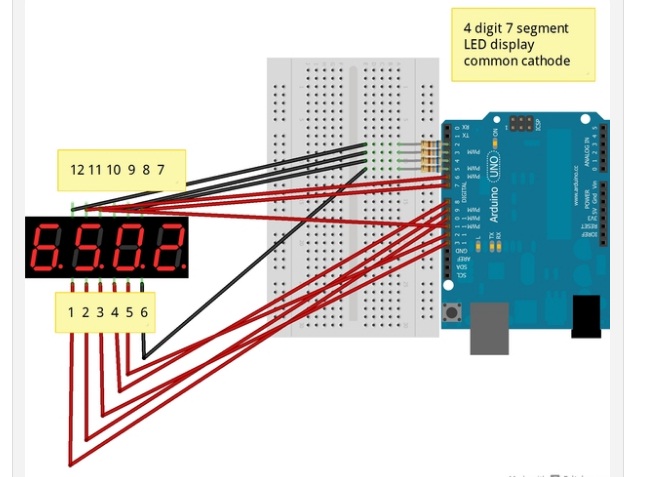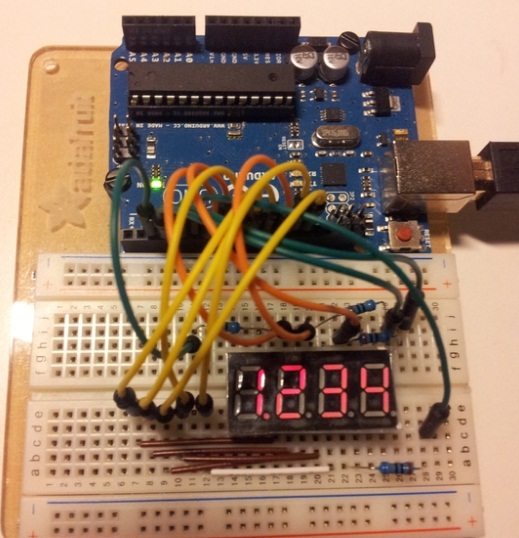Arduino 4 digit 7 segment display
7-Segment Display เป็นอุปกรณ์อิเล็กทรอนิกส์ที่พบเห็นได้บ่อย ใช้แสดงตัวเลขฐานสิบที่มีหลายหลัก (Digits) อุปกรณ์ชนิดนี้ ประกอบด้วยไดโอดเปล่งแสง (LED) ทั้งหมด 7 ตัว รวมไว้ในตัวถังเดียวกัน (ถ้ารวมจุด หรือ decimal point จะมี LED ทั้งหมด 8 ตัว) โดยถูกจัดวางตำแหน่งให้สามารถแสดงผลเป็นตัวเลข 0 ถึง 9 ได้ โดยส่วนใหญ่ LED ที่ใช้นั้นจะให้แสงสีแดง
ในการเลือกใช้งาน ก็มีหลายขนาด แต่ที่สำคัญคือ แบ่งได้เป็นสองประเภทหลักคือ Common-Anode (CA) ซึ่งหมายถึง LED ทั้งหมดจะมีขาแอโนดร่วมกัน และ Common-Cathode (CC) ซึ่งหมายถึง LED ทั้งหมดจะมีขาแคโทดร่วมกัน ดั้งนั้นต้องเลือกให้ถูกประเภท และรูปแบบในการนำไปต่อวงจร ก็แตกต่างกันด้วย
สวัสดีครับ วันนี้เรามาลองเขียนโปรแกรมให้ Arduino แสดงผลออก 7 segment แบบ 4 digi กันนะครับ
การต่อสายระหว่าง arduino กับตัว 7 segment ให้ดูในภาพนี้นะครับ

ตัวอบ่าง code ที่ใช้ในการทดสอบในบทความนี้นะครับก็สามารภ copy แล้วไปวางบน arduino ได้เลยครับ
boolean DigitOn = LOW;
boolean DigitOff = HIGH;
boolean SegOn=HIGH;
boolean SegOff=LOW;
int DigitPins[] = {2, 3, 4, 5}; // สำหรับต่อแต่ละหลัก
int SegmentPins[] = {6, 7, 8, 9, 10, 11, 12, 13}; // สำหรับต่อแต่ละขา
//
//N is for numbers and NxP is a number with a decimal point behind
int BLANK[] = {LOW, LOW, LOW, LOW, LOW, LOW, LOW, LOW};
int N0[] = {HIGH, HIGH, HIGH, HIGH, HIGH, HIGH, LOW, LOW};
int N0P[] = {HIGH, HIGH, HIGH, HIGH, HIGH, HIGH, LOW, HIGH};
int N1[] = {LOW, HIGH, HIGH, LOW, LOW, LOW, LOW, LOW};
int N1P[] = {LOW, HIGH, HIGH, LOW, LOW, LOW, LOW, HIGH};
int N2[] = {HIGH, HIGH, LOW, HIGH, HIGH, LOW, HIGH, LOW};
int N2P[] = {HIGH, HIGH, LOW, HIGH, HIGH, LOW, HIGH, HIGH};
int N3[] = {HIGH, HIGH, HIGH, HIGH, LOW, LOW, HIGH, LOW};
int N3P[] = {HIGH, HIGH, HIGH, HIGH, LOW, LOW, HIGH, HIGH};
int N4[] = {LOW, HIGH, HIGH, LOW, LOW, HIGH, HIGH, LOW};
int N4P[] = {LOW, HIGH, HIGH, LOW, LOW, HIGH, HIGH, HIGH};
int N5[] = {HIGH, LOW, HIGH, HIGH, LOW, HIGH, HIGH, LOW};
int N5P[] = {HIGH, LOW, HIGH, HIGH, LOW, HIGH, HIGH, HIGH};
int N6[] = {HIGH, LOW, HIGH, HIGH, HIGH, HIGH, HIGH, LOW};
int N6P[] = {HIGH, LOW, HIGH, HIGH, HIGH, HIGH, HIGH, HIGH};
int N7[] = {HIGH, HIGH, HIGH, LOW, LOW, LOW, LOW, LOW};
int N7P[] = {HIGH, HIGH, HIGH, LOW, LOW, LOW, LOW, HIGH};
int N8[] = {HIGH, HIGH, HIGH, HIGH, HIGH, HIGH, HIGH, LOW};
int N8P[] = {HIGH, HIGH, HIGH, HIGH, HIGH, HIGH, HIGH, HIGH};
int N9[] = {HIGH, HIGH, HIGH, HIGH, LOW, HIGH, HIGH, LOW};
int N9P[] = {HIGH, HIGH, HIGH, HIGH, LOW, HIGH, HIGH, HIGH};
int MIN[] = {LOW, LOW, LOW, LOW, LOW, LOW, HIGH, LOW};
//The letters K, M, N, T, V, W, Z are off limits with a 7 segment display
//Some letters like D, G, Q are hard to recognize, as D is like O and G like 6
int A[] = {HIGH, HIGH, HIGH, LOW, HIGH, HIGH, HIGH, LOW};
int B[] = {HIGH, HIGH, HIGH, HIGH, HIGH, HIGH, HIGH, LOW};
int C[] = {HIGH, LOW, LOW, HIGH, HIGH, HIGH, LOW, LOW};
int D[] = {HIGH, HIGH, HIGH, HIGH, HIGH, HIGH, LOW, LOW};
int E[] = {HIGH, LOW, LOW, HIGH, HIGH, HIGH, HIGH, LOW};
int F[] = {HIGH, LOW, LOW, LOW, HIGH, HIGH, HIGH, LOW};
int G[] = {HIGH, LOW, HIGH, HIGH, HIGH, HIGH, HIGH, LOW};
int H[] = {LOW, HIGH, HIGH, LOW, HIGH, HIGH, HIGH, LOW};
int I[] = {LOW, HIGH, HIGH, LOW, LOW, LOW, LOW, LOW};
int J[] = {LOW, HIGH, HIGH, HIGH, HIGH, LOW, LOW, LOW};
int L[] = {LOW, LOW, LOW, HIGH, HIGH, HIGH, LOW, LOW};
int O[] = {HIGH, HIGH, HIGH, HIGH, HIGH, HIGH, LOW, LOW};
int P[] = {HIGH, HIGH, LOW, LOW, HIGH, HIGH, HIGH, LOW};
int Q[] = {HIGH, HIGH, HIGH, HIGH, HIGH, HIGH, LOW, HIGH};
int R[] = {HIGH, HIGH, HIGH, LOW, HIGH, HIGH, HIGH, LOW};
int S[] = {HIGH, LOW, HIGH, HIGH, LOW, HIGH, HIGH, LOW};
int U[] = {LOW, HIGH, HIGH, HIGH, HIGH, HIGH, LOW, LOW};
int Y[] = {LOW, HIGH, HIGH, HIGH, LOW, HIGH, HIGH, LOW};
//Array of pointers for the 4 digits
int* lights[4];
//char array coming from the serial interface
//4 numbers or chars, 4 optional decimal points, 1 end-of-line char
char incoming[9] = {};
void setup() {
Serial.begin(9600);
for (byte digit=0;digit<4;digit++) {
pinMode(DigitPins[digit], OUTPUT);
}
for (byte seg=0;seg<8;seg++) {
pinMode(SegmentPins[seg], OUTPUT);
}
//initialize display with 1.234
lights[0] = N1P;
lights[1] = N2;
lights[2] = N3;
lights[3] = N4;
}
void loop() {
//read the numbers and / or chars from the serial interface
if (Serial.available() > 0) {
int i = 0;
//clear the array of char
memset(incoming, 0, sizeof(incoming));
while (Serial.available() > 0 && i < sizeof(incoming) - 1) {
incoming[i] = Serial.read();
i++;
delay(3);
}
Serial.println(incoming);
//tmp is for the incoming string and counter for the 4 digits
int counter = -1;
for (int tmp = 0; tmp < 9; tmp++) {
counter++;
switch(incoming[tmp]){
case '0':
if (tmp < 8 && (incoming[tmp + 1] == '.' || incoming[tmp + 1] == ',')) {
lights[counter] = N0P;
tmp++;
} else {
lights[counter] = N0;
}
break;
case '1':
if (tmp < 8 && (incoming[tmp + 1] == '.' || incoming[tmp + 1] == ',')) {
lights[counter] = N1P;
tmp++;
} else {
lights[counter] = N1;
}
break;
case '2':
if (tmp < 8 && (incoming[tmp + 1] == '.' || incoming[tmp + 1] == ',')) {
lights[counter] = N2P;
tmp++;
} else {
lights[counter] = N2;
}
break;
case '3':
if (tmp < 8 && (incoming[tmp + 1] == '.' || incoming[tmp + 1] == ',')) {
lights[counter] = N3P;
tmp++;
} else {
lights[counter] = N3;
}
break;
case '4':
if (tmp < 8 && (incoming[tmp + 1] == '.' || incoming[tmp + 1] == ',')) {
lights[counter] = N4P;
tmp++;
} else {
lights[counter] = N4;
}
break;
case '5':
if (tmp < 8 && (incoming[tmp + 1] == '.' || incoming[tmp + 1] == ',')) {
lights[counter] = N5P;
tmp++;
} else {
lights[counter] = N5;
}
break;
case '6':
if (tmp < 8 && (incoming[tmp + 1] == '.' || incoming[tmp + 1] == ',')) {
lights[counter] = N6P;
tmp++;
} else {
lights[counter] = N6;
}
break;
case '7':
if (tmp < 8 && (incoming[tmp + 1] == '.' || incoming[tmp + 1] == ',')) {
lights[counter] = N7P;
tmp++;
} else {
lights[counter] = N7;
}
break;
case '8':
if (tmp < 8 && (incoming[tmp + 1] == '.' || incoming[tmp + 1] == ',')) {
lights[counter] = N8P;
tmp++;
} else {
lights[counter] = N8;
}
break;
case '9':
if (tmp < 8 && (incoming[tmp + 1] == '.' || incoming[tmp + 1] == ',')) {
lights[counter] = N9P;
tmp++;
} else {
lights[counter] = N9;
}
break;
case '-':
lights[counter] = MIN;
if (tmp < 8 && (incoming[tmp + 1] == '.' || incoming[tmp + 1] == ',')) {
tmp++;
}
break;
//with letters the decimal point is ignored!
//if you need it, just write AP, BP etc with HIGH in the last position
case 'a': //falls through to the next case
case 'A':
lights[counter] = A;
if (tmp < 8 && (incoming[tmp + 1] == '.' || incoming[tmp + 1] == ',')) {
tmp++;
}
break;
case 'b': //falls through to the next case
case 'B':
lights[counter] = B;
if (tmp < 8 && (incoming[tmp + 1] == '.' || incoming[tmp + 1] == ',')) {
tmp++;
}
break;
case 'c': //falls through to the next case
case 'C':
lights[counter] = C;
if (tmp < 8 && (incoming[tmp + 1] == '.' || incoming[tmp + 1] == ',')) {
tmp++;
}
break;
case 'd': //falls through to the next case
case 'D':
lights[counter] = D;
if (tmp < 8 && (incoming[tmp + 1] == '.' || incoming[tmp + 1] == ',')) {
tmp++;
}
break;
case 'e': //falls through to the next case
case 'E':
lights[counter] = E;
if (tmp < 8 && (incoming[tmp + 1] == '.' || incoming[tmp + 1] == ',')) {
tmp++;
}
break;
case 'f': //falls through to the next case
case 'F':
lights[counter] = F;
if (tmp < 8 && (incoming[tmp + 1] == '.' || incoming[tmp + 1] == ',')) {
tmp++;
}
break;
case 'g': //falls through to the next case
case 'G':
lights[counter] = G;
if (tmp < 8 && (incoming[tmp + 1] == '.' || incoming[tmp + 1] == ',')) {
tmp++;
}
break;
case 'h': //falls through to the next case
case 'H':
lights[counter] = H;
if (tmp < 8 && (incoming[tmp + 1] == '.' || incoming[tmp + 1] == ',')) {
tmp++;
}
break;
case 'i': //falls through to the next case
case 'I':
lights[counter] = I;
if (tmp < 8 && (incoming[tmp + 1] == '.' || incoming[tmp + 1] == ',')) {
tmp++;
}
break;
case 'j': //falls through to the next case
case 'J':
lights[counter] = J;
if (tmp < 8 && (incoming[tmp + 1] == '.' || incoming[tmp + 1] == ',')) {
tmp++;
}
break;
case 'l': //falls through to the next case
case 'L':
lights[counter] = L;
if (tmp < 8 && (incoming[tmp + 1] == '.' || incoming[tmp + 1] == ',')) {
tmp++;
}
break;
case 'o': //falls through to the next case
case 'O':
lights[counter] = O;
if (tmp < 8 && (incoming[tmp + 1] == '.' || incoming[tmp + 1] == ',')) {
tmp++;
}
break;
case 'p': //falls through to the next case
case 'P':
lights[counter] = P;
if (tmp < 8 && (incoming[tmp + 1] == '.' || incoming[tmp + 1] == ',')) {
tmp++;
}
break;
case 'q': //falls through to the next case
case 'Q':
lights[counter] = Q;
if (tmp < 8 && (incoming[tmp + 1] == '.' || incoming[tmp + 1] == ',')) {
tmp++;
}
break;
case 'r': //falls through to the next case
case 'R':
lights[counter] = R;
if (tmp < 8 && (incoming[tmp + 1] == '.' || incoming[tmp + 1] == ',')) {
tmp++;
}
break;
case 's': //falls through to the next case
case 'S':
lights[counter] = S;
if (tmp < 8 && (incoming[tmp + 1] == '.' || incoming[tmp + 1] == ',')) {
tmp++;
}
break;
case 'u': //falls through to the next case
case 'U':
lights[counter] = U;
if (tmp < 8 && (incoming[tmp + 1] == '.' || incoming[tmp + 1] == ',')) {
tmp++;
}
break;
case 'y': //falls through to the next case
case 'Y':
lights[counter] = Y;
if (tmp < 8 && (incoming[tmp + 1] == '.' || incoming[tmp + 1] == ',')) {
tmp++;
}
break;
case 1 ... 43: counter--; break;//special chars are ignored
//44 to 46 are , - .
case 47: counter--; break;//special chars are ignored
//chars between Z and a
case 91 ... 96: counter--; break;//special chars are ignored
case 123 ... 127: counter--; Serial.println("above 122"); break;//special chars are ignored
default: lights[counter] = BLANK;
}
} //end for
//show the input values
for (int y = 0; y < 4; y++) {
Serial.print(y);
Serial.print(": ");
for (int z = 0; z < 8; z++) {
Serial.print(lights[y][z]);
}
Serial.println("");
}
} //end if, i.e. reading from serial interface
//This part of the code is from the library SevSeg by Dean Reading
for (byte seg=0;seg<8;seg++) {
//Turn the relevant segment on
digitalWrite(SegmentPins[seg],SegOn);
//For each digit, turn relevant digits on
for (byte digit=0;digit<4;digit++){
if (lights[digit][seg]==1) {
digitalWrite(DigitPins[digit],DigitOn);
}
//delay(200); //Uncomment this to see it in slow motion
}
//Turn all digits off
for (byte digit=0;digit<4;digit++){
digitalWrite(DigitPins[digit],DigitOff);
}
//Turn the relevant segment off
digitalWrite(SegmentPins[seg],SegOff);
} //end of for
}







